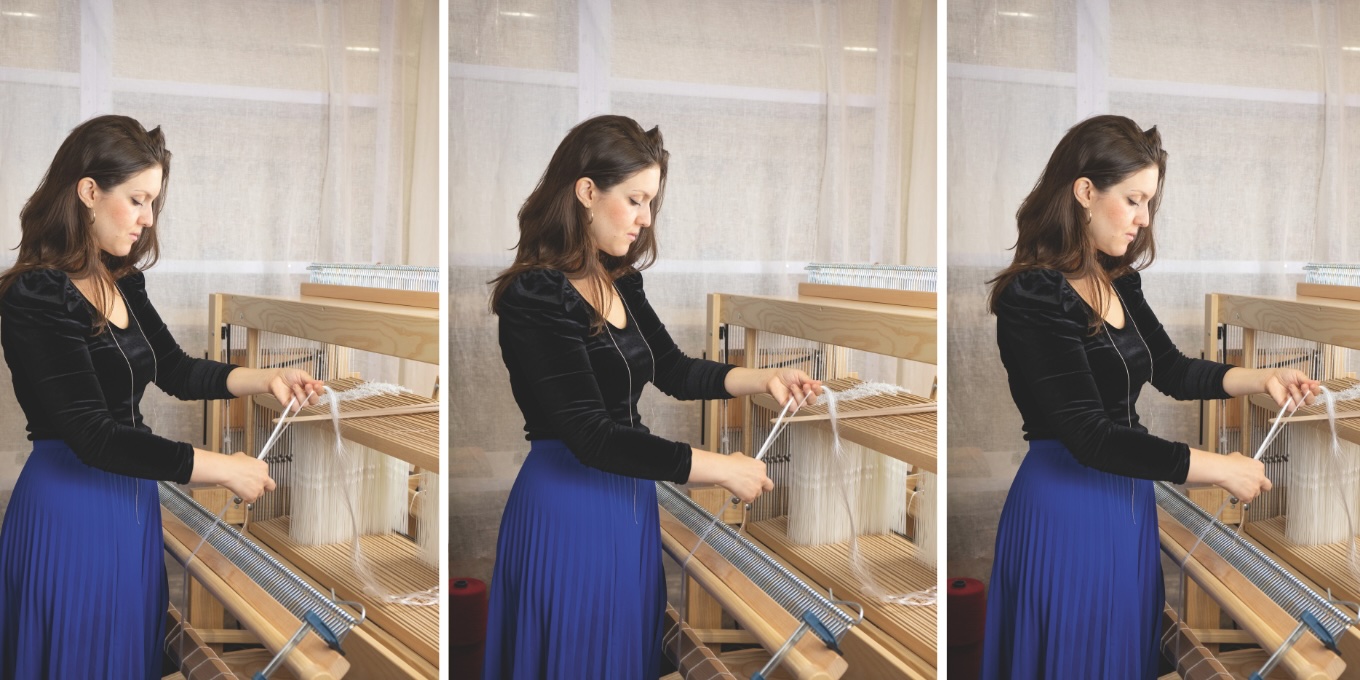
Leblanc uses natural fibres whenever possible, sometimes mixed with recycled materials, and all are from traceable sources. One of her more unique projects was for Dior creative director Maria Grazia Chiuri’s fall/winter 2021/2022 haute couture collection. The concept was to take deadstock denim, pull it apart and reweave it, yarn by yarn, to embellish the collar of a navy-blue suit designed for the runway. Small cream-coloured ceramic beads were added to the fabric, evoking pebbles glimpsed through the rolling current of a fast-flowing river. “The difficulty is in creating something with recycled materials, conceiving something from uneven stock in terms of quantity and maintaining a unique and consistent colour,” says Leblanc of the fabric. Discussing the laborious process, she references the story of Penelope, the wife of Odysseus, who spent her days weaving a shroud only to undo her work each night to thwart the suitors she had promised to meet upon its completion. This sensitivity to the creative process and her ability to find the story in each piece allows her materials to sing.
Leblanc became curious about working with glass when she met glass-maker Lucile Viaud in 2016 during a two-year residency at the prestigious Ateliers de Paris. Viaud is the originator of a particular type of glass she makes from natural materials and by-products, such as oyster shells and algae. They hit it off and began thinking of how they could collaborate. “At first, it was almost like a joke—a bit of fun—as our materials were such opposites,” says Leblanc. “But little by little, we realized that they could be combined to create an innovative hybrid material.”
While glass has been used in weaving in the past as a novelty, the material is fragile and difficult to work with, but it becomes pliable and sinuous thanks to Leblanc’s innovative craftsmanship. Viaud’s “eco-glass,” as they have dubbed it, must be stretched to create long fibres that can be used in the weaving done by Leblanc. While a loom can usually be worked successfully by one person, the creation of this fabric requires the two artists to work in tandem—Viaud adds the glass fibre lengths as Leblanc works the semi-electric loom—with a technique that marries art and science. The creative partners used the material in a special piece of decor that hangs from the ceiling of acclaimed chef Nicolas Conraux’s Michelin-starred restaurant, La Table de La Butte, in France’s Brittany region, and they continue to look for other possible applications in fashion, art and interior design.
Last year, Leblanc and Viaud became the first female duo to be honoured in the Dialogues category of the Prix Liliane Bettencourt Pour l’Intelligence de la Main, a coveted prize that recognizes innovation and mastery of technique, and were awarded the equivalent of just under $220,000 to continue the development of their work together. While Leblanc takes some time off for maternity leave, she will continue making her exceptional fabrics available to haute couture houses. She and Viaud also plan to work on unique manufacturing tools to further their eco-glass fabric and allow them to experiment even more freely. “Thanks to the [prize], we’re developing a network of decorators, gallerists and chefs—a magical and inspiring environment that we love working in.”
